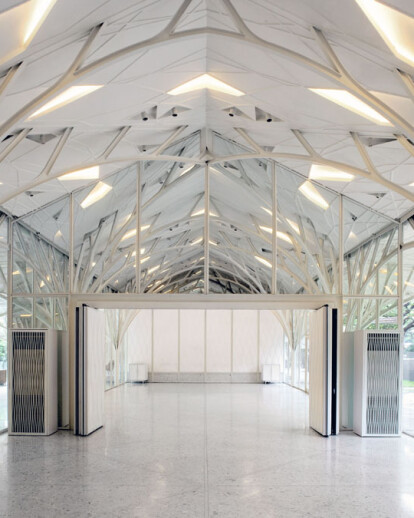A series of disused buildings from Mumbai’s colonial past set within the Mumbai Race Course are to be converted to form a series of restaurant and bars. The conservation guidelines call for the preservation of the roof profile for three-quarters of the buildings and full conservation for the remaining one-quarter.
The interesting aspect of the site, however, lies not in the colonial buildings but in the open spaces covered by mature Rain Trees. These spaces are shaded throughout the year by the thinly wide spread leaves of the Rain Trees, allowing almost the entire proposed program to occur outdoors.
Our proposal attempts to continue this idea of a continuously differentiated space, with no clear boundary, into the envelope of the conservation building. A new structure is proposed within the old building envelope. The structural system adopted here is that of a tree-branch. The propagation of the branching system along the longitudinal section of the conserved building is differentiated in its growth along the transverse section. This differentiation reorganizes the old buildings with new dining programs. Therefore each dining program (wine bar, restaurant, pre-function and banquet facilities) is captured within a different spatial volume, defined by the variable degree of the branching structure. As the structure branches into finer structural members as it approaches the ceiling. When the branches touch the ceiling, the ceiling plane is punctured with a series of openings corresponding to the intersection of the branches with the purlins and rafters. These openings become light coves and slits.
The tree structure was designed to be a steel truss and the challenge lay in working through the construction system compatible with local skills. Rather than looking at steel fabricators within the building construction sector, we sourced boiler fabricators for high precision work. We explored two sectional profiles for the truss, a box section and an I-section. The choice of the I-section was based on the fact that the web could be laser cut to ensure dimensional precision, while relying on the skilled fabricators to weld the flanges on and assemble the truss accurately. The truss geometry was altered for smooth branching as opposed to an angular one to reduce the number of weld joints. The success of the installation is that the final product conceals the fabrication method and appears to be a system of curved sections.
The interior of the Lounge Bar on the upper level is an intricate arrangement of 3-dimensional, faceted wooden panelling, acoustically treated with sound proofing material. The pattern of the panelling is a series of trees with intersecting branches. We devised a 3 point co-ordinate system to map out the pattern onto the walls of the heritage wing, given the 3 dimensional nature of the panelling and that each intersecting point had a totally different x,y and z co-ordinate. This system allowed local craftsmen using fairly primitive tools to achieve a high level of fit and finish for the interior works. The faceted panelling is finished in walnut veneer with bronze channels making up the tree pattern.

































